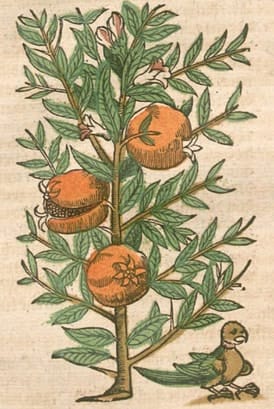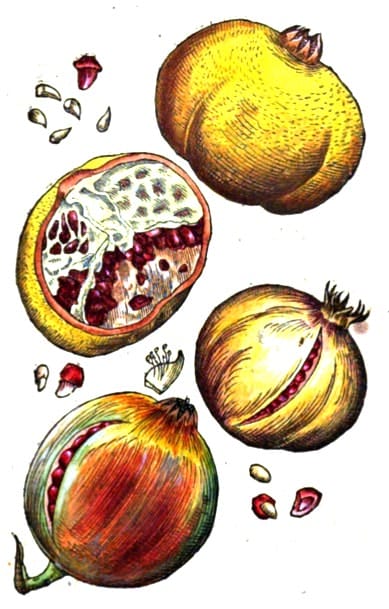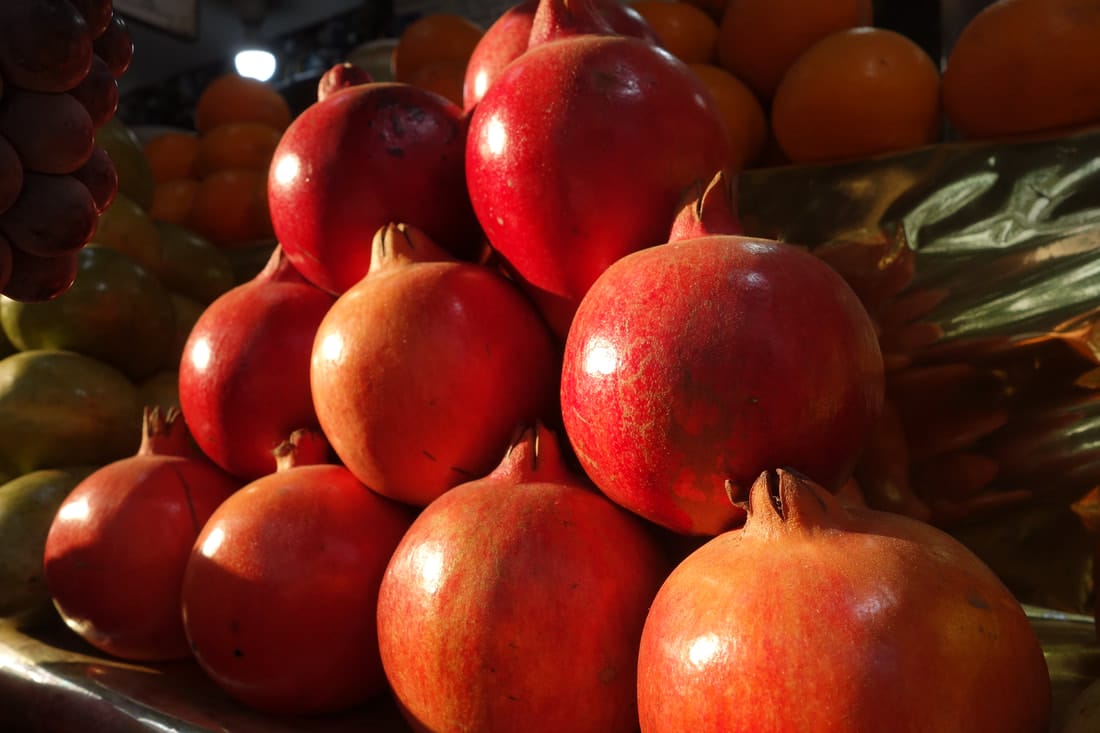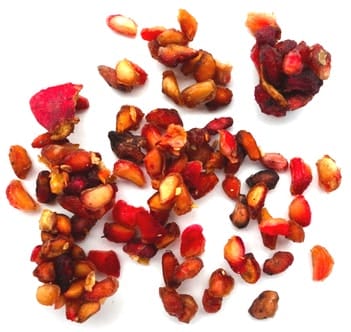Punica Fructus, Pomegranate fruit
Shi Liu Zi (TCM)Se bru སེ་འབྲུ (Tibetan)
Dadima (Ayurveda)
Anardana (Unani)
 Krauterbuch, Lonitzer, 1578
Krauterbuch, Lonitzer, 1578 Kreutterbuch, Matthiolus, 1586
Kreutterbuch, Matthiolus, 1586
 Pomegranate Fruit (Adam, 2019)
Pomegranate Fruit (Adam, 2019) |
 Dried Pomegranate fruit as used in
Dried Pomegranate fruit as used inAyurveda and Tibetan Medicine (Adam, 2016) |
 Members CLICK HERE for the PRO VERSION
Members CLICK HERE for the PRO VERSIONBotanical name:
Punica granatum
Parts used:
Fruit; the dried, ripe fruit-seed are used in Tibetan Medicine and Ayurveda.
Unani physicians differentiate between 3 main varieties:
i. Sweet: good for Heat; tonic to the Vital Organs
ii. Sour: clears Heat, antibilious; for Vomiting and Diarrhea
iii. Sweet-Sour: similar to the Sweet, but stronger. Better for Heat-types
Temperature & Taste:
FRESH FRUIT: Cool, moist. Sweet, Sour.
DRIED FRUIT: Neutral. Sweet, sour.
Sweet Pomegranate is more warming to the Stomach; Sour clears Stomach Heat and Heartburn (Dioscorides)
Classification:
3B. FEBRIFUGE & ANTIPYRETIC. 3D. CORDIALS & CARDIACS
4c. CARDIAC. 4e. STOMACHIC. 4g. HEPATIC
TCM:
B. Clear Heat
Uses:
1. Warms the Stomach, Benefits the Stomach (West, Tibetan):
-increases digestive heat and improves digestion; ‘Good for the Stomach’ (Dioscorides)
-stops nausea, vomiting, Diarrhea from Bile (Dried)
-Diarrhea (dried), Heartburn (fresh) (Sour Pomegranate, Dioscorides)
Note: Sour, fresh and the juice is better for Heat and Heartburn; the Sweet and the dried is warming and strengthening to the Stomach
2. Clears Cold and Wind:
-General to benefit Cold and Wind disorders
-Cough, Spasmodic Cough, Whooping Cough
3. Clears Heat, Benefits the Heart:
-regarded as Cordial and good for the Heart
-Palpitations, Heart weakness
-“All the varieties benefit in cases of Palpitation and “cleanse” the Heart” (Avicenna)
4. Stops Bleeding:
-“When the seeds of pomegranate are taken orally with rain water, they stop Hemoptysis”. (Avicenna)
5. Externally:
-the slightly concentrated juice is applied to the eyes to strengthen Eyesight
-Sour juice boiled and mixed with Honey is applied to sores of the Mouth and Genitals, and spreading Ulcers (Dioscorides)
FRESH FRUIT or JUICE: Cooling, refrigerant, especially in Fever, Stomach Heat, Biliousness.
DRIED FRUIT: Warming, strengthens the Stomach
SWEET FRUIT: Benefits Blood and Yin; Consumption, general Weakness; good for Coughs (juice)
SOUR FRUIT: Heat of the Stomach; Choleric Fevers; Biliousness; Gonorrhea; Pica in Women with Child

Dose:
Powder: 1–4 grams
Decoction: 3–9 grams
Juice: 100–300 mls.
Comment:
… available in PRO version
Substitute:
… available in PRO version
Main Combinations:
1. Coldness of the Stomach, Indigestion and difficulty Breathing:
i. Pomegranate seed, … available in PRO version
ii. add … available in PRO version
2. Obstruction of the channels of circulation, and to warm the Stomach … available in PRO version
3. Severe Nausea:
i. Sweet and Sour Pomegranate juices … available in PRO version
ii. boil Pomegranate juice with … available in PRO version
4. Whooping Cough, Spasmodic Cough, Pomegranate Ripe fruit, … available in PRO version
5. Pains in the Heart or Palpitations from Heat:
i. Pomegranate juice with … available in PRO version
ii. boil Sweet and Sour Pomegranate juice together with … available in PRO version
6. Menopause, Pomegranate fruit, … available in PRO version
7. Piles, juice of green Pomegranate fruit, … available in PRO version
Major Compounds:
Powder for Chronic Diarrhea (Nicholas)
Pomegranate 5 (Se bru 5) (Tibetan Medicine)
Calcite 6 Powder (Tibetan Medicine)
Raisin 7 (Tibetan Medicine)
Golden 11 (Gser mdog 11) (Tibetan Medicine)
Cautions:
None noted
Main Preparations used:
Juice, Syrup of Pomegranate
-
Extra Info
-
History
|
‘The pomegranate which by Dierbach’s account is the [?] of Hippocrates, is a native of the South of Europe, Arabia, Japan, Persia, and Barbary. It is now much cultivated in India, but the Indian fruit is greatly inferior to that which is imported from the Persian Gulf ports. The Sanskrit name is Dadima. Hindu physicians prescribe the juice of the ripe fruit combined with saffron as a cooling medicine. They also use the rind of the fruit and the flowers, combined with aromatics, such as cloves, cinnamon, coriander, pepper, &c., as an astringent in such bowel affections as are not accompanied with tenesmus. In the Concan the juice of the green fruit, rubbed with Galls, Cloves and Ginger is given in honey as a remedy for piles. The juice of the flowers with Durva root juice (Cynodon dactylon) is used to stop bleeding from the nose. The root bark does not appear to be mentioned in any Sanskrit works on Materia Medica. The Arabs call the pomegranate Ruman, Anar is the Persian name. Mahometan writers describe three kinds, sweet, sour, and subacid (the Ruman-i-bari of these |
writers is not a pomegranate). Besides using the flowers and rind in a variety of ways on account of their astringency, they recommend the root bark as being the most astringent part of the plant, and a perfect specific in cases of tapeworm; it is given, in decoction, prepared with two ounces of fresh bark, boiled in a pint and a half of water till but three-quarters of a pint remain; of this when cold a wineglassful may be drunk every half hour, till the whole is taken. This dose sometimes sickens the stomach a little, but seldom fails to destroy the worm, which is soon after passed. The seeds of the pomegranate are considered to be stomachic, the pulp cardiacal and stomachic. It would appear that the Arabs derived their knowledge of the medicinal qualities of this plant from the Greeks, as a similar account of them is found in Dioscorides. The balaustium of Dioscorides and Pliny is the double pomegranate flower, a word which in the corrupted form of Balusitun is common in Arabic and Persian books. The root bark and rind of the fruit are official in the Pharmacopoeia of India’. (Vegetable Materia Medica of Western India, Dymock, 1885) |
